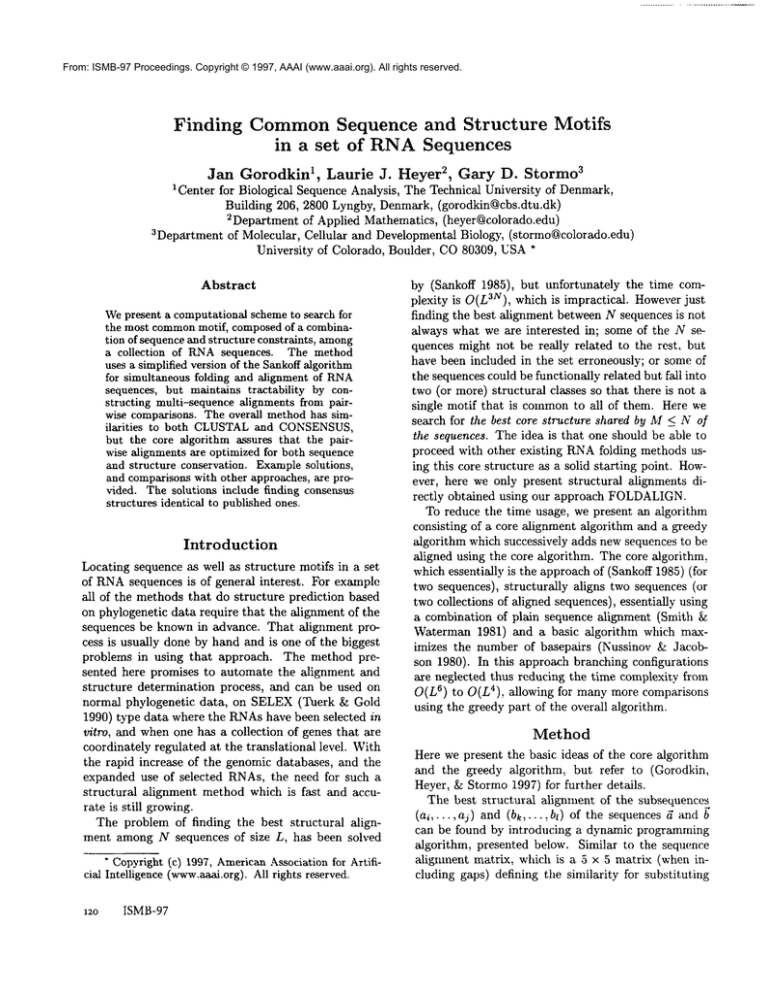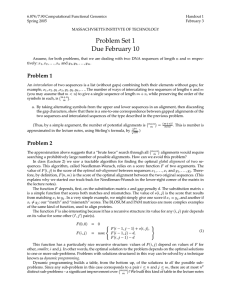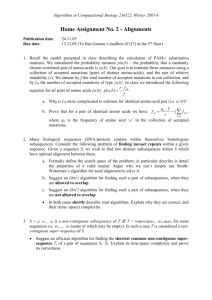
From: ISMB-97 Proceedings. Copyright © 1997, AAAI (www.aaai.org). All rights reserved.
Finding
CommonSequence and Structure
in a set of RNASequences
Motifs
Jan Gorodkin 1, Laurie
J. Heyer 2, 3Gary D. Stormo
1 Center for Biological Sequence Analysis, The Technical University of Denmark,
Building 206, 2800 Lyngby, Denmark, (gorodkin@cbs.dtu.dk)
2Department of Applied Mathematics, (heyer@colorado.edu)
3Department of Molecular, Cellular and Developmental Biology, (stormo@colorado.edu)
University of Colorado, Boulder, CO80309, USA*
Abstract
~Vepresent a computational schemeto search for
the most commonmotif, composedof a combination of sequenceand structure constraints, among
a collection of RNAsequences. The method
uses a simplified version of the Sankoffalgorithm
for simultaneous folding and alignment of RNA
sequences, but maintains tractability by constructing multi-sequence alignments from pairwise comparisons. The overall method has similarities
to both CLUSTAL
and CONSENSUS,
but the core algorithm assures that the pairwise alignments are optimized for both sequence
and structure conservation. Examplesolutions,
and comparisonswith other approaches, are provided. The solutions include finding consensus
structures identical to published ones.
Introduction
Locating sequence as well as structure motifs in a set
of RNAsequences is of general interest. For example
all of the methods that do structure prediction based
on phylogenetic data require that the alignment of the
sequences be known in advance. That alignment process is usually done by hand and is one of the biggest
problems in using that approach. The method presented here promises to automate the alignment and
structure determination process, and can be used on
normal phylogenetic data, on SELEX(Tuerk & Gold
1990) type data where the RNAshave been selected in
v/tro, and when one has a collection of genes that are
coordinately regulated at the translational level. With
the rapid increase of the genomic databases, and the
expanded use of selected RNAs, the need for such a
structural alignment method which is fast and accurate is still growing.
The problem of finding the best structural alignment among N sequences of size L, has been solved
* Copyright (c) 1997, AmericanAssociation for Artificial Intelligence (~-w.aaai.org). All rights reserved.
120
ISMB-97
by (Sankoff 1985), but unfortunately the time complexity is O(L3N), which is impractical. Howeverjust
finding the best alignment between N sequences is not
always what we are interested in; some of the N s~
quences might not be really related to the rest, but
have been included in the set erroneously; or some of
the sequences could be functionally related but fall into
two (or more) structural classes so that there is not
single motif that is commonto all of them. Here we
search for the best core structure shared by M< N of
the sequences. The idea is that one should be able to
proceed with other existing RNAfolding methods using this core structure as a solid starting point. However, here we only present structural alignments directly obtained using our approach FOLDALIGN.
To reduce the time usage, we present an algorithm
consisting of a core alignment algorithm and a greedy
algorithm which successively adds new sequences to be
aligned using the core algorithm. The core algorithm,
which essentially is the approach of (Sankoff 1985) (for
two sequences), structurally aligns two sequences (or
two collections of aligned sequences), essentially using
a combination of plain sequence alignment (Smith
Waterman 1981) and a basic algorithm which maximizes the number of basepairs (Nussinov & Jacobson 1980). In this approach branching configurations
are neglected thus reducing the time complexity from
O(L~) to O(L4), allowing for many more comparisons
using the greedy part of the overall algorithm.
Method
Here we present the basic ideas of the core algorithm
and the greedy algorithm, but refer to (Gorodkin,
Heyer, & Stormo 1997) for further details.
The best structural alignnmnt of the subsequences
(ai .... ,aj) and (bk,...,b~) of the sequences g and
can be found by introducing a dynamic programming
algorithm, presented below. Similar to the sequence
alignment matrix, which is a 5 x 5 matrix (when including gaps) defining the similarity for substituting
bases with each other, we can here define a 25 x 25
scoring matrix, Sij,kl, over all quadruples, including
gaps. Such a matrix defines the similarity of substituting one pair of bases with another. This score matrix can, in a natural way, be directly related to the
usual sequence alignment matrix along with another
5 x 5 matrix listing the degree of complementarity of
between the various bases. Hence for any scoring matrix and the constraint of non-branching structures,
the maximumscoring subsequence alignment can be
obtained from the four-dimensional matrix Dij,kt from
the following recursion:
D(i+l)(j-1),(k+l)(l-1)
+
Dqj-~),(~+l)(~_~} + S-j,kl,
f
i
D(i+l)j,(k+l)(l-1)
Si -,k/,
D(i+l)(j-1),k(t-D
Sij,-t,
D(i+l)(j-~),(,+,)l + Sij,k-,
D(i+D(j-D,kt
Dij,kl
= max
+ Sij,--,
Dij,(k+~)(L-x)
S--,kh
D(~+~)j,(~+,)~+ S~-,,-,
Di(j-l),k(|-l)
+ S-j,-1,
D(i+l)j,k(l-1)
+ Si-,-l,
Di(j-1),(k+1)z
+ S-j,~-,
D(~+l)j,kl + S~-,--,
D~(j-i),kt
S-j,--,
Dij,(k+l)l
+ S--,k-,
Dij,k(t-~)
S--,-t
The maximal Dij,kz provides the maximal similarity
between the two sequences. One difference between
this recursion and that of plain sequence alignment, is
there is no zero value. This is because the matrix D
indicates both ends of the alignment, ai with bk and aj
with bl, and also because we have to allow for negative
values to occur within the complete alignment.
By considering a structural alignment as one consensus sequence with preassigned structure, the dynamic
programming algorithm can be extended to aligning
two collections of alignments against each other. However, in that alignment process each of the sequences
is aligned to every other sequence, and the structure
componentof the _S matrix is applied for aligned positions for which both collections contain basepairs.
With this general schemeof aligning any size collection to any size collection, we maybuild up greedy algorithms like those used for CLUSTALW
(Thompson,
Higgins, & Gibson 1994) and CONSENSUS
(Hertz,
Haxtzell,III, &Stormo 1990). The basic idea of building up these kinds of comparisons is to pairwise compare all individual sequences to each other, then compare all the pairwise alignments to all the individual
sequences, such that no sequence appears more than
once in each comparison. The next greedy step would
be to align all the triplet alignments to the individual
sequences, and compare all the pairwise alignments to
themselves, still such that no sequence appears more
than once in each final alignment. The algorithm may
then be continued until all sequences have been compared in a final alignment. Clearly this approach explodes in time. Thus we need efficient procedures to
eliminate alignments that are not useful. For the results presented below we only include comparisons between single sequences and r - 1 sequences to obtain
alignments of size r. Andwe use a threshold s (typically 30) of the best alignments after each "round" r.
In this approach, the time complexity at each round is
O(L4r2s(N r) ), fo r a to tal co mplexity of O(L4N4s).
In selecting the "best" alignment of M<__ N sequences,
there is a problem that scores increase with the number of sequences. As a preliminary analysis we look
at a few best alignments of each round r, and compare
score versus alignment length, and find a trade off from
which the final alignment is chosen.
Results
Weselect four published data sets for investigation,
all from SELEXexperiments and for which a consensus structure has been proposed. The first set (H1)
of RNAwas found to bind to the human immunodeficiency virus type 1 rev protein (Tuerk et al. 1992).
The second set (H2) contains a pseudoknot with specific affinity for HIV-1-RT(Tuerk, MacDougai,& Gold
1992). The third set (THEO) of RNAbinds to
bronchodilator theophylline (Jenison et al. 1994).
The fourth set (R17) is RNAligands for the bacteriophage R17 coat protein (Schneider, Tuerk, & Gold
1992). The length of all the sequences is in the range
of 30 to 50 nucleotides, and the data set sizes range
from 13 to 36 sequences.
Using other
approaches
To compare with our scheme presented above we first
tried a few other methodswhich are publicly available.
First, we performed multiple alignment of the SELEX data by using the program CLUSTALW
with default parameters. Since this program performs multiple alignment based on sequence conservation alone,
we do not expect it to identify structurally conserved
regions. As expected, on data sets with significant
amounts of sequence conservation it does fairly well
at identifying those. In the R17 data, the conserved
hairpin loop with A bulge is aligned, but it does not
provide a consistent alignment of the conserved stem
region. For the H2 data set, which contains a pseudoknot, where the one basepair region is conserved in
sequence, but the other is not, only the sequence conGorodkin
121
served region is found. The THEOdata contains sequence conservation, but it is misaligned in the two
subclasses. The H1 data has less sequence conservation than the others and is not aligned well.
Next, we applied the COVEprogram (Eddy
Durbin 1994) to structurally align the data sets. This
stochastic context-free grammar approach which considers mutual information is similar to the work of
(Sakakibara et al. 1994). COVE
performs global alignment on a collection of sequences and has been shown
to perform well on tRNAfor which a global (consensus)
structure is defined. It is well knownthat it is hard to
find local features using a global alignment procedure,
so we did not expect this package to perform well on
the SELEXdata sets, and it did not. Using the same
data sets as for CLUSTALW
we did not find any strong
signals for consensus structures, not even if we used the
CLUSTALW
alignments as input to the program. The
multiple structural alignment method presented here
can be used to construct a core model which can then
be used by COVEto extend and refine that model.
The Vienna RNApackage (Hofacker et al. 1994)
(see references therein) includes a program IZNAfold
to find the minimumfree energy structures, and a program RNAdistance to find the distance between two
structures in terms of the smallest cost along the editing path when representing the structures as trees.
Wefolded each sequence in the data sets and found
that many of the structures resembled the published
structures, when neglecting the H2 pseudoknot. Using
RNAdistance to pairwise compare the structures and
appropriate cut-off scores to select reasonable comparisons, we found a number of sequences with similar
structures (in the respective data sets) were clustered
together. However, we did not find a strongest commonstructure, or the consensus structure for the respective data sets.
FOLDALIGN
For each of the investigated data sets we did find the
subset with the strongest commonmotif in sequence
and structure, matching what has been published.
The data set H1 has been assigned three structural
classes. The classes all contain the same structural
elements, the largest class consisting of 10 sequences.
However, three of them use the constant SELEXregions in the basepairing (which were not included in
our data sets), so we would not expect to find more
than seven of them with conserved structure.
For
those seven sequences FOLDALIGN
finds the published alignment as shown in Table 1. Furthermore
FOLDALIGN
succeeds in merging the two strongest
classes, getting only one sequence wrong in tim align122
IS/rIB-97
ment. (All of the sequences in the third class utilize
part of the constant region in their structures, and so
cannot be aligned properly with the other sequences.)
The additional structure identified by FOLDALIGN
(Table 1), but not included in the published consensus
structure, is included in the consensus structure for the
largest class (Figure 3 of (Tuerk et al. 1992)).
Table 1: The strongest aligned class of the HI data set.
The parentheses indicate predicted basepairing, the underscore complete matching for a column. The numbersrefers
to the published sequence labels. Onlythe aligned part of
the sequences are shown.
GGAUUUGAGAUACAC-GGAA-GUGGICUCUCC
17
GCC-UUGAGAUACACUAUAUAGUGGAC-CGGC
5
GGC-UGGAGAUACAAACUAU-UUGG-CUCGCC
4a
AUU---GAGAAAC
A C-GUUU-GUGG&CUCGGU
6b
ACC-UUGAGGUACUC-UUAA-CAGG-CUCGGU
11
GCA -UUGAGAAACAC-GIIUU-GUGG
ACUCIJGU
6a
GAA-IYOGAGAAACAC-UA l -CUGGCCUCUUU
14
((( .........
(( ........
)) .....)))
(((...(_(.._((
........))_.).))))
Even better results are obtained for the data set
H2. As mentioned this data set contains a pseudoknot, two overlapping stem-loop regions, and therefore violates the knot constraint in dynamic programming. One stem region is highly conserved in sequence,
and the other has almost no sequence conservation.
FOLDALIGN
aligns the sequence conserved regions
based on their sequence alignment, but at the same
time aligns the other stem region which only is conserved in structure (see Table 2). Weanticipate that
other folding approaches, given this alignment, easily
will predict the pseudoknot (Cary & Stornm 1995).
Table 2: The strongest aligned class of the H2 data
set. The parentheses indicate basepairing (and the square
brackets for pseudoknot), the underscore complete alignment for a column. The numbers refers to the published
sequencelabels. Onlythe aligned part of the sequencesare
shown.
CCAGAGGCCCAACUC~UAAACC,
GGC 1.17
CCG-AAGCUCAACGGGAUAAUGAGC
2.4a
CCG-AIGCCGAACGGGAAAACCGGC
1.3a
CC-CAAGCGC-AGGGGAGAA-GCGC
1.6
CCG-ACGCCA-ACGGGAGAA-UGGC
1.8
CCuUOutICAG-UCC,
GGAAAAAOJGA
I. 1
CCGUUACUCC-UCGGGAUAAAGGAG
2.11
CCGUAAGAGG
- A CGGGAUAAACCUC
2.7a
CCG-UAGGAG-GCCW,
GAUAU-CUCC
R. 10
CCG--UGCCG-GCOW~AUAU-CGGC
I. 9b
CCG-AACUCG-ACCW~AUAA-CGAG
2. lb
CCG--ACUCG--COGGAUAk-CGAG
2.12
[[ .... ((((.... ]] .....))))(publ.)
....((((
. ._..))))(FOLDALIGN)
The third data set, THEO,consists of two structural classes which are circular permutations of each
other. FOLDALIGN
identifies the proper motif from
the largest class, getting the alignment exactly right
for six of the eight sequences. The two remaining sequences contain the shortest stems, only two basepairs
in one case, and require the most gaps for proper align-
ment. The second class could not be aligned with the
first due to the circular permutation, but their common
structure should be identifiable if they are treat~ed as
a separate class (not tested).
The final set, R17, consists of 36 sequences. For
manyof these part of the structural motif is contained
in the constant SELEXregion of the sequence, and
so not available to the program for alignment. However, we obtained a perfect alignment for the subset of
nine sequences that have at least six basepairs in the
stem. Wealso found a perfect alignment for 12 of 16
sequences with at least five basepair stems. Alignment
of larger subsets are nearly correct, although they do
contain a few misaligned sequences.
Conclusion
Wehave presented a method to structurally align a set
of RNAsequences, as well as selecting the subsets containing the most significant alignments. The method
was able to fully find the published alignments of conserved motifs. The complete structure was not always
obtained, as in the case of the pseudoknot, due to the
dynamic programming limitation. But the core alignment that is obtained can be used by existing methods to complete the motif identification. For this type
of problem the method clearly outperforms the other
commonlyused methods applied, and we conclude that
our method, to a very large extent, can replace the
alignments currently made by hand, or provide significant hints to assist with "hands-on" methods.
Acknowledgements
Thanks to B. Javoruik and NexStar for providing the
data electronically.
Wethank S. Eddy for advice on
the use of COVE.This work was sponsored in part by
NIH grant HG00249to GDS. JG was supported by the
Danish National Research Foundation.
References
Cary, R. B., and Stormo, G. D. 1995. Graph-theoretic
approach to RNAmodeling using comparative data.
In Proceedings of the third International Conference
on Intelligent Systems in Molecular Biology, 75-80.
Eddy, S., and Durbin, R. 1994. RNAsequence analysis using covariance models. Nucleic Acids Research
22:2079-2088.
(http://genome.wustl.edu/eddy/#cove).
Gorodkin, J.; Heyer, L. J.; and Stormo, G. D. 1997.
Finding the most significant
commonsequence and
structure motifs in a set of RNAsequences, submitted.
Hertz, G. Z.; Hartzell,III, G. W.; and Stormo, G. D.
1990. Identification
of consensus patterns in tin-
aligned dna sequences knownto be functionally
lated. CABIOS6(2):81-92.
re-
Hofacker, I. L.; Fontana, W.; Stadler, P. F.; Bonhoeffer, L. S.; Tacker, M.; and Schuster, P. 1994.
Fast folding and comparison of RNAsecondary
structures.
Monatshe~e f~r Chemie 125:167-188.
(http://www.tbi.univie.ac.at/-ivo/RNA/).
Jenison, R. D.; Gill, S. C.; Pardi, A.; and Polisky,
B. 1994. High-resolution molecular discrimination by
RNA. Science 263:1425-1429.
Nussinov, R., and Jacobson, A. B. 1980. Fast algorithm for predicting the secondary structure of singlestranded RNA.Procedings of the National Academy
of Science USA77:6309-6313.
Sakakibara, Y.; Brown, M.; Underwood,R. C.; Mian,
I. S.; and Haussler, D. 1994. Stochastic contextfree grammars for modeling RNA.In Hunter, L., ed.,
Proceedings of the Twenty-Seventh Annual Hawaii International Conference on System Sciences: Biotechnology Computing, vol. V, 284-293. IEEE Computer
Society Press.
Sankoff, D. 1985. Simultaneous solution of the
RNAfolding, alignment and protosequence problems.
SIAM J. Appl Math 45(5):810-825.
Schneider, D.; Tuerk, C.; and Gold, L. 1992. Ligands
to the bacteriophage R17 coat protein. Journal of
Molecular Biology 228:862-869.
Smith, T. F., and Waterman,M. S. 1981. Identification of commonmolecular subsequences. Journal of
Molecular Biolo9y 147:195-197.
Thompson, J. D.; Higgins, D. G.; and Gibson,
T. J. 1994. CLUSTAL
W: improving the sensitivity
of progressive multiple sequence alignment through
sequence weighting, positions-specific gap penalties
and weight matrix choice. Nucleic Acids Research
22:4673-4680.
Tuerk, C., and Gold, L. 1990. Systematic evolution of
ligands by exponential enrichment: RNAligands to
bacteriophage T4 DNApolymerase. Science 249:505510.
Tuerk, C.; MacDougal,S.; Hertz, G. Z.; and Gold, L.
1992. In vitro evolution of functional nucleic acids:
High-affinity RNAligands of the HIV-1 rcv protein.
In Ferr6, F.; Mullis, K.; Gibbs, R.~ and Ross, A.,
eds., The Polymerase Chain Reaction. Birkhanser,
Springer-Verlag NY.
Tuerk, C.; MacDougal, S.; and Gold, L. 1992. RNA
pseudoknots that inhibit human immunodeficiency
virus type 1 reverse transcriptase. Procedings of the
National Academy of Science USA 89:6988-6992.
Gorodkin
123







